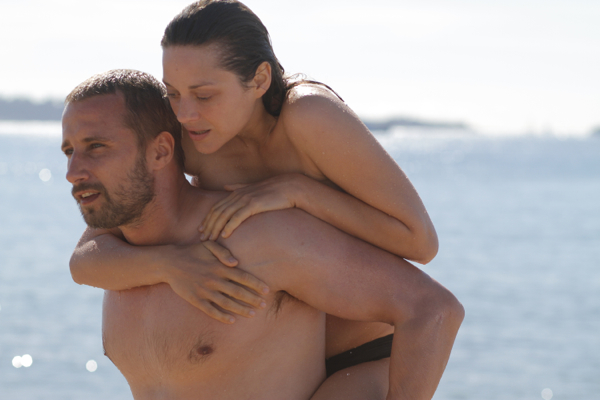Movie review by Greg Carlson
For those willing to accept the often blunt beauty-and-the-beast theme that has been a go-to story device far longer than the movies have been around, Jacques Audiard’s “Rust and Bone” can be as bracing as the ocean swim taken by Marion Cotillard’s Stephanie, a Cote d’Azur marine park killer whale trainer whose legs are amputated following a freak accident on the job. Based on Craig Davidson’s short story collection of the same title, director Jacques Audiard uses the film to examine brutishness, grief, the limits of the body, and the intersection of physical and psychological pain.
Cotillard’s star power looms over the movie, but the principal figure is Matthias Schoenaerts’ Ali, a miserable, aimless tough who, along with his young son, relocates to his sister’s place in Antibes long after his luck has run out. Ali’s emotional maturity is no greater than his kid’s, and Audiard sets up a minefield of opportunities for poor choices as Ali takes dead-end gigs as a club bouncer and as an assistant to a shady, quasi-legal surveillance tech. Before long, Ali finds his way to underground, bare-knuckle street fighting, an activity we imagine he would undertake even if it didn’t pay out in cash. Without functioning on the operatic level of “The Master,” Schoenaert’s character is every bit as crude and unlikable as Joaquin Phoenix’s Freddie Quell.
Cotillard’s Stephanie is as complex as Ali is primal and pitiless. They reconnect during Stephanie’s rehabilitation and even though the circumstances of their acquaintance might outwardly point toward the contrived banalities of the most sentimental melodramas (she’ll help him, he’ll mend her), Cotillard easily transcends any limits the material might place upon her. Following a matter-of-fact agreement to initiate a sexual relationship merely as “friends with benefits,” Stephanie, who wants to know if “it still works,” is as surprised as we are to discover deeper feelings – apparently unreciprocated – for Ali.
Among other things, “Rust and Bone” functions on one level as an unlikely love story, and while the enjoyment derived by the audience in watching the fractured, broken couple lurch one step forward and two steps back may not always match the pleasure Audiard takes in the accounting, “Rust and Bone” has a way of setting its hooks. On paper, the content of the narrative would be at home in the silent era, but Audiard pulls off the unlikely feat of rehabilitating many of the weakest tendencies of stories about disability, about fighting, and about parental responsibility.
Audiard deliberately withholds some of the interiority that would reveal more of Ali and Stephanie to us, but the lack of viewer privilege serves to reinforce Ali’s ugly, tactless shortcomings as father, brother, friend, and lover. We wonder briefly whether Stephanie, wallowing in the abject and flirting with self-pity (she has “gauche” and “droite” tattooed on her thighs), possesses enough self-awareness and self-possession to realize that adjusting Ali’s basic instincts is a fool’s errand. It’s a safe bet that Ali’s inability to express any great measure of empathy for Stephanie creates the conditions by which she can comfortably interact with him. There, and elsewhere, the masterful Audiard is more than capable of finding the sweet spot between the flesh and the spirit.
